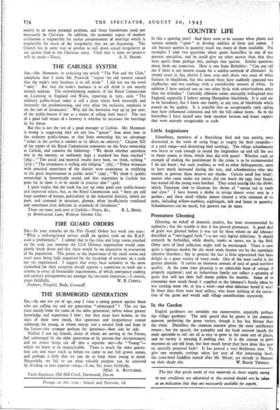COUNTRY LIFE
Is this a sporting year? And there seem to be seasons when plants and various animals " sport " or develop oddities of form and colour. I ask because queries in quantity reach me, many of them insoluble. For examples I took two questions about queer butterflies to one of our greatest specialists, and he could give no other answer than that they were sports from perhaps this, perhaps that species. Similar questions about birds are numerous. Here is one from Berkshire: "Can you tell me if there is any known reason for a sudden outbreak of albinism? In twenty years in this district I have seen only about two cases of white feathers in blackbirds, but this season there have suddenly appeared two chaffinches and two starlings with a considerable amount of white. In addition I have noticed one or two other birds with white feathers other than the orthodox." Certainly albinism seems unusually. widespread over England, especially I believe among Hampshire blackbirds. It is said not to be hereditary, but I knew one family, at any rate, of blackbirds which passed on the quality. It is possible that an exceptionally early spring may have influenced coloration and left the full colour latent. As to the butterflies I have myself seen both meadow browns and lesser coppers that were scarcely recognisable as such.
Little Augustuses
Schoolboys, members of a flourishing bird and tree society, were discovered at the work of using frogs as targets for their catapults— at a yard range—and destroying bird nestlings. The village schoolmaster was brave or rash enough to round the ringleaders up and tell the rest to throw stones at them, which they did with gusto! Whether such an example of making the punishment fit the crime is to be recommended I do not know ; but such cruelties, as well as other delinquencies, seem to have much increased during the war, and schoolmasters who take trouble to prevent them deserve our thanks. Certain small boy birds'- nesters who came under my notice did not touch the eggs they found, but waited till the young were hatched. They acted exactly like the shrike, which Tennyson took to illustrate his theme of " nature red in tooth and claw." I have known a shrike to ravage almost every nest in a garden ; and these small villains almost cleared a wide common of its nests, including willow-warblers, nightingale, lark and linnet in quantity. Schoolmasters can do much, but parents can do more.
Premature Gleaning Gleaning, on behalf of domestic poultry, has been recommended by authority ; but the trouble is that it has proved premature. A good deal of grain was gleaned before it was cut by those whom an old labourer described as " two-legged birds "—a not very logical definition. It should certainly be forbidden, while shocks, stooks or mows are in- the- field. Other sorts of food collection might well be encouraged. There is now quite a vigorous market for the weed seeds thrown out by the cunningly selective threshers ; but in general the fact is little appreciated that hens delight in a great variety of weed. seeds. One of the most useful is the greater plantain. It carries an immense amount of seed, of good nutritive quality. At the same time gleaning is an admirable form of salvage if properly regulated ; and an industrious family can collect a quantity of grain that will last their half dozen pullets for months. Some of us remember how much bread it supplied to the labourer's family when he was earning some as. or less a week—and what delicious bread it was! In those days there were local millers, who knew nothing of the extrac- tion of the germ and would mill village contributions separately.
In the Garden English gardeners are certainly too conservative, especially perhaps the village gardener. The only gourd that he grows is the common marrow, preferring the green variety, though it has less flavour than the white. Doubtless the common marrow gives the most satisfactory return ; but the squash, the- pumpkin and the bush marrow (much the most agreeable to eat) are all as easy to grow in the same sort of places, and its variety is amusing if nothing else. It is the custom to grow marrows on any old heap, but how much better they have done this year on specially prepared beds! It has proved a very floriferous year. To give one example, cuttings taken last year of that interesting bush, the cross-bred buddleia named after Mr. Meyer, are already in blossom The fact that goods made of raw materials in short supply owing to war conditions are advertised in this tournal should not be Warn as an indication that they are necessarily available for export.


























 Previous page
Previous page